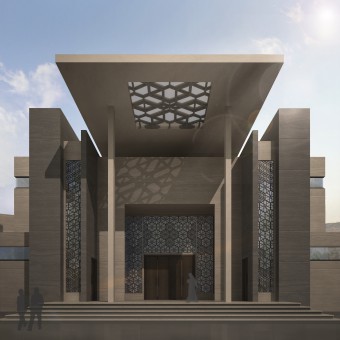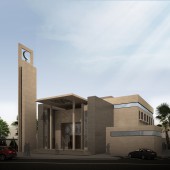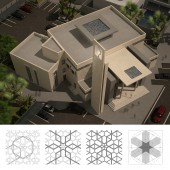DESIGN NAME:
Salam
PRIMARY FUNCTION:
Mosque
INSPIRATION:
The main aspect in the design concept is presenting the historical supposition of the mosques in Saudi Arabia on the basics of scale hierarchy for users regarding to mass of the mosques, the pattern of the facades and the relations between the main characteristics in the mosque.
UNIQUE PROPERTIES / PROJECT DESCRIPTION:
The proposed design suggests a new prospect of district mosques in Saudi Arabia, where the most important holy places for Muslims are existed, by redefining the main characteristics of the traditional mosque. The multiple masses, which maintain the monumental style and make it at the same time more humanistic, the various movement relations and the Hypostyle influence in the prayer hall interior design, are the main features of the proposed design.
OPERATION / FLOW / INTERACTION:
- The architectural Perception of the mosque for the worshipers: in the past the architectural mass of mosque is being conscious to the worshiper as a completely monumental mass, the design proposes more humanistic scale, which is translated into a hierarchy of the multiple masses in the project, and maintain simultaneously the monumental style.
- Circulations representation to encourage the interaction between the users and the building by three relations: in-out: the entry, the shoe removal& racking and the storage. Out-in: the ablution, the imam residence, semi out-in: the Imam & Muezzin entrance.
- Hypostyle influence: prayer hall interior design and the covered entrance evokes the sense of the Hypostyle plan, which one of its most important features is to be supported by columns, but in a modern way of thinking regarding to the dome design.
PROJECT DURATION AND LOCATION:
The project is located in Al-Medina city, Saudi Arabia. It was presented to the client in January 2017.
FITS BEST INTO CATEGORY:
Architecture, Building and Structure Design
|
PRODUCTION / REALIZATION TECHNOLOGY:
Main Design Software: AutoCAD, SketchUp, 3ds Max, Vray, Photoshop CS. Exterior Outer walls is mixed between grey marble façade (regional marble) and white stone of Riyadh. Structure is reinforced concrete planar covered slabs (exposed white concrete with aggregates of dolomite rock & sand). It is envisioned as a series of adjacent beam ribs, inter-connected continuously along length to form the pattern, which is repeated in the ceiling. Interior Surfaces are exposed white finishing with wooden slabs on the walls.
SPECIFICATIONS / TECHNICAL PROPERTIES:
Height Architectural: 13.1 meters Height without the minaret. Total area: 1313.9 square meters. Width: 28.5 meters Length: 39.1 meters. Ground floor plan: 764 square meters. First floor: 241 square meters. Building capacity of worshippers: 400 to 650. Imam & Muezzin Residence building .area: 292 square meters.
TAGS:
Religious architecture, mosque, contemporary mosque, minimal architecture, district mosque design
RESEARCH ABSTRACT:
Designing the mosque involved specific challenges for architectural designer: the program requirements, the governance requirements, the traditional forms and conservative styles. The first research field was attempting to understand the functional program, the architectural circulations, the traditional styles and Saudi Arabian requirements for Mosques. The other research field was to look through the recent examples of contemporary mosque architecture. Besides, researching how the designer speaks to the young generations of Muslims but respects the traditions in mosques architecture.
CHALLENGE:
How to design a mosque in the most famous Muslim Pilgrimage destinations in the world with the same traditional features of the mosque but in a contemporary flavor? How to give a district mosque identity with a very limited area and strict and detailed requirements? How to redefine the main characteristics of the mosque to conform the present and simultaneously respect traditional context?
These questions tended to receive some replies in the proposed architectural design.
ADDED DATE:
2017-02-21 11:42:22
TEAM MEMBERS (2) :
Structural engineer: Abdullelah Al-Yousef and Architecture team: Alaa Al-Nouri, Raghad Meslmani, Rahaf Meslmani, Sara Al-Bitar, Walaa Hajali and Anas Al-Yousef
IMAGE CREDITS:
Azimuth For Architecture & Design, 2016.
|










